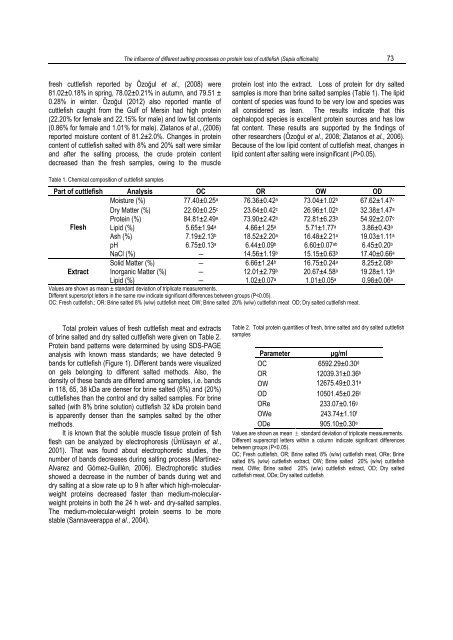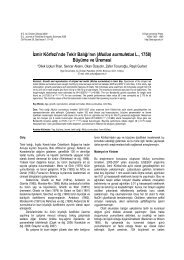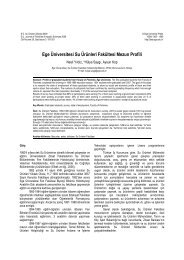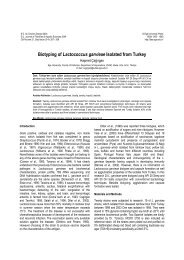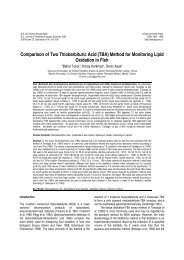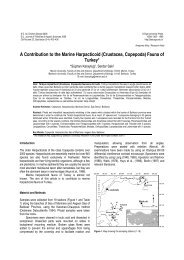Sepia officinalis - Journal of Fisheries and Aquatic Sciences
Sepia officinalis - Journal of Fisheries and Aquatic Sciences
Sepia officinalis - Journal of Fisheries and Aquatic Sciences
Create successful ePaper yourself
Turn your PDF publications into a flip-book with our unique Google optimized e-Paper software.
The influence <strong>of</strong> different salting processes on protein loss <strong>of</strong> cuttlefish (<strong>Sepia</strong> <strong><strong>of</strong>ficinalis</strong>) 73<br />
fresh cuttlefish reported by Özoğul et al., (2008) were<br />
81.02±0.18% in spring, 78.02±0.21% in autumn, <strong>and</strong> 79.51 ±<br />
0.28% in winter. Özoğul (2012) also reported mantle <strong>of</strong><br />
cuttlefish caught from the Gulf <strong>of</strong> Mersin had high protein<br />
(22.20% for female <strong>and</strong> 22.15% for male) <strong>and</strong> low fat contents<br />
(0.86% for female <strong>and</strong> 1.01% for male). Zlatanos et al., (2006)<br />
reported moisture content <strong>of</strong> 81.2±2.0%. Changes in protein<br />
content <strong>of</strong> cuttlefish salted with 8% <strong>and</strong> 20% salt were similar<br />
<strong>and</strong> after the salting process, the crude protein content<br />
decreased than the fresh samples, owing to the muscle<br />
protein lost into the extract. Loss <strong>of</strong> protein for dry salted<br />
samples is more than brine salted samples (Table 1). The lipid<br />
content <strong>of</strong> species was found to be very low <strong>and</strong> species was<br />
all considered as lean. The results indicate that this<br />
cephalopod species is excellent protein sources <strong>and</strong> has low<br />
fat content. These results are supported by the findings <strong>of</strong><br />
other researchers (Özoğul et al., 2008; Zlatanos et al., 2006).<br />
Because <strong>of</strong> the low lipid content <strong>of</strong> cuttlefish meat, changes in<br />
lipid content after salting were insignificant (P>0.05).<br />
Table 1. Chemical composition <strong>of</strong> cuttlefish samples<br />
Part <strong>of</strong> cuttlefish Analysis OC OR OW OD<br />
Moisture (%) 77.40±0.25 a 76.36±0.42 a 73.04±1.02 b 67.62±1.47 c<br />
Dry Matter (%) 22.60±0.25 c 23.64±0.42 c 26.96±1.02 b 32.38±1.47 a<br />
Protein (%) 84.81±2.49 a 73.90±2.42 b 72.81±6.23 b 54.92±2.07 c<br />
Flesh Lipid (%) 5.65±1.94 a 4.66±1.25 a 5.71±1.77 a 3.86±0.43 a<br />
Ash (%) 7.19±2.13 b 18.52±2.20 a 16.48±2.21 a 19.03±1.11 a<br />
pH 6.75±0.13 a 6.44±0.09 b 6.60±0.07 ab 6.45±0.20 b<br />
NaCl (%) ― 14.56±1.19 b 15.15±0.63 b 17.40±0.66 a<br />
Solid Matter (%) ― 6.66±1.24 b 16.75±0.24 a 8.25±2.08 b<br />
Extract Inorganic Matter (%) ― 12.01±2.79 b 20.67±4.58 a 19.28±1.13 a<br />
Lipid (%) ― 1.02±0.07 a 1.01±0.05 a 0.98±0.06 a<br />
Values are shown as mean ± st<strong>and</strong>ard deviation <strong>of</strong> triplicate measurements.<br />
Different superscript letters in the same row indicate significant differences between groups (P


